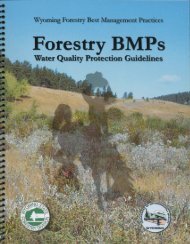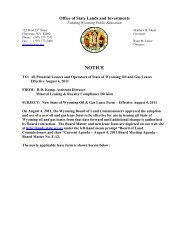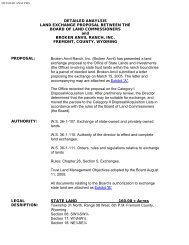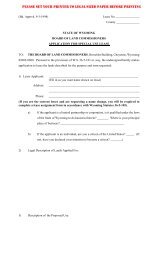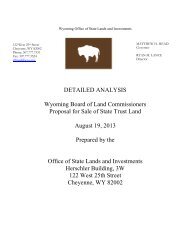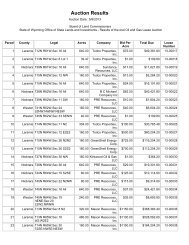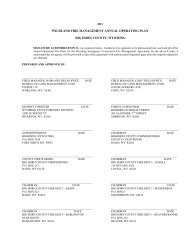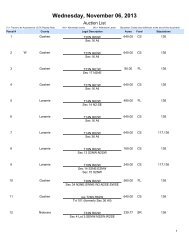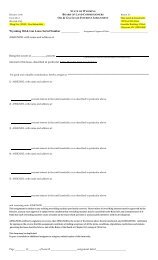Best Management Practices - Wyoming State Lands
Best Management Practices - Wyoming State Lands
Best Management Practices - Wyoming State Lands
You also want an ePaper? Increase the reach of your titles
YUMPU automatically turns print PDFs into web optimized ePapers that Google loves.
General census of populationhousing & establishmentsEmirate of Dubai2005Demographic Characteristics of Population2005• In the year 2005 , total population in Dubai Emirate has reached (1,321,453) individuals ofwhich (989,305) are males representing (74.86%), and (332,148) are females representing(25.14%) of the total population included in the to census which carried out in DubaiEmirate.• In the period falling between (2000 -2005) censuses revealed that the population growthin Dubai Emirate has percents (7.32%) for males ( 8.24%) and (4.83%) females.• The average male population growth in Dubai Emirate is higher than that of females.This is primarily due to a big percentage of non-local labour force especially unskilled onewhich comes to Dubai without families. Such increase resulted in the rise of male sex to(298 males for each 100 females) in the year 2005.• The sex ratio differs significantly between rural and urban areas where male population inDubai urban area is threefold than females in the year 2005 (299 males for each 100females). However, in Dubai rural area male population is more than double the female(216 males for each 100 females). Also, the sex ratio differs considerably among differentareas inside the Emirate.• The average household size including servants reached (4.16) , (4.14) individuals in urbanareas to (5.64) in rural areas. Thus, the average differs considerably among different areasinside the Emirate.• On the level of the Emirate ,Population density reached (1.69) individuals per room , year2005. The population density differs from (1.69) individuals for each room in urban areasto (1.67) individuals per room in the rural areas. The average differs greatly amongdifferent areas inside the Emirate. The difference in population density is due to thedifference in service and economic activities inside the Emirate of Dubai and the numberof buildings and rooms occupied in each area.1
Remastered with permission from Montana <strong>State</strong> UniversityExtension Forestry.Adapted and remastered for <strong>Wyoming</strong> <strong>State</strong> Forestry Division &<strong>Wyoming</strong> Department of Environmental Quality byPafti, Inc.P.O. Box 190161Hungry Horse, MT 59919(406)-387-5649Original Publication Author:ROBERT LOGANForestry SpecialistMontana <strong>State</strong> University Extension ServicePhotography credits:D.J. Bakken (1)Bud Clinch (40)John Garland (1)Skip Hegman (4)Paul Hansen (3)Peter Lesica (3)Alan Levno (2)Robert Logan (86)George Mathieus (1)Bill Swanson (1)Craig Thomas (5)Montana Department of Fish, Wildlife & Parks (4)Dean Sircuek (5)F.H. Stoltze Land & Lumber Co. (4)Chris Tootell (1)US Forest Service, Region 1 (3)US Forest Service, Rocky Mountain Ranger Station (4)US Geological Survey (1)Weldwood of Canada (19)Steve Wirt (3)Patrick Heffernan (1)US Forest Service Rocky Mountain Region Center for Design &Interpretation (15)Reviewed by:Buck Peterson, <strong>Wyoming</strong> SawmillsMark Conrad, <strong>Wyoming</strong> DEQBob McDowell, <strong>Wyoming</strong> Game and FishJim Arnold, <strong>Wyoming</strong> <strong>State</strong> Forestry DivisionChuck Harnish, Wyomimg DEQ, retired<strong>Wyoming</strong>'s forest lands supply beauty, water,wildlife, minerals, recreation, forage, timber andjobs. This book is dedicated to the stewardshipof those qualities – especially pure water.Surface water from <strong>Wyoming</strong> forests supplies35% of <strong>Wyoming</strong>'s residents. Described hereare <strong>Best</strong> <strong>Management</strong> <strong>Practices</strong> (BMPs) thatprotect water quality and forest soils. BMPs arevoluntary and represent preferred ways to manageforest land that conserve and protect waterquality during forest management activities. BMPsare effective. Field audits, conducted in 2004 indicatemore than 90 percent compliance. BMPs areintended for all forest lands, including non-industrialprivate, forest industry, state-owned and federalforests.If you own forest land, work in the forestor are interested in forests, this publication is foryou. It contains BMP guidelines and explainsreasons for using BMPs, not just rules.However, reading these pages is not enough.Maintaining our forests’ productivity andbenefits can only be achieved by on-the-groundapplication of BMPs.How you apply BMPs in the forest will requirepractice and personal judgement. Two notationsused in this book are intended to help.#24The “do not” symbol indicates practices youshould avoid.Indicates BMPs adopted by the <strong>State</strong> of<strong>Wyoming</strong> and the corresponding practice numberin the 2004 Nonpoint Source <strong>Management</strong>Plan. The complete text of the <strong>Wyoming</strong>BMPs can be obtained from <strong>Wyoming</strong> DEQ or<strong>Wyoming</strong> <strong>State</strong> Forestry Division.The need to safeguard the future of our waterresources is essential. With the cooperation of allforest users, and the application of theinformation on these pages, we can protect thewater quality of <strong>Wyoming</strong>'s forestlands.Thank you for doing your best to put BMPs towork in the forest.Be aware that BMPs can and probably willchange. Our knowledge of the forest will increaseover time. Forest owners and managers will havenew techniques, new equipment, and differentneeds. The organizations listed on this page canhelp with information and education.“The forests of <strong>Wyoming</strong> are also the headwatersfor several major river basins. These landsproduce large quantities of high quality water.This water nurtures some of the West's bestfisheries and is used for irrigation, recreationand livestock, as well as sustaining <strong>Wyoming</strong>’scities, towns and communities. I applaud theefforts of private landowners, the forest industryand the state and federal agencies that areworking together to protect the quality of<strong>Wyoming</strong>’s water through the implementationof these Forestry BMPs”.Governor Dave Freudenthal“Forestry BMPs have proven to be effective inprotecting water quality during timber harvestoperations. The use of BMPs is currently voluntary;this publication represents a proactiveeffort between the Environmental ProtectionAgency, the WY Department of EnvironmentalQuality, the WY <strong>State</strong> Forestry Division, ForestIndustry, and other state and federal agencies.Working together, we can maintain the productivityof <strong>Wyoming</strong>’s forested landscapes whileprotecting the states valuable water resource”.Bill Crapser, <strong>Wyoming</strong> <strong>State</strong> Forester<strong>Wyoming</strong> <strong>State</strong> Forestry Division1100 W. 22nd. StreetCheyenne, WY 82002(307) 777-7586<strong>Wyoming</strong> Department of Environmental Quality122 W. 25th. Street, Herschler BuildingCheyenne, WY 82002(307) 777-7937<strong>Wyoming</strong> Timber Industry AssociationP.O. Box 6088Sheridan, WY 82801(605) 341-0875Montana <strong>State</strong> University Extension Forestry32 Campus DriveMissoula, MT 59812-0606(406) 243-2773CONTRIBUTORS TO THE PUBLICATION:WY Department of Environmental Quality (EPA 319 grant)WY <strong>State</strong> Forestry Division<strong>Wyoming</strong> Timber Industry AssociationUS Forest ServiceMT <strong>State</strong> University Extension ForestryMT Department of Natural Resources & Conservation****Indicates additional recommended practices



